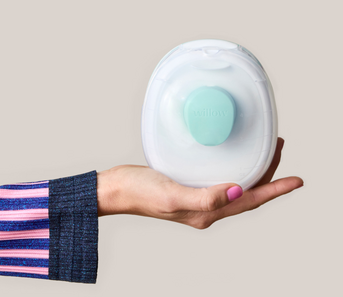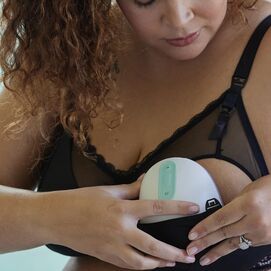Erica Djossa is a registered psychotherapist, maternal mental health advocate, and the founder of Momwell, a platform on a mission to support moms through virtual courses, therapy, and community building. She recently published “Releasing the Mother Load: How to Carry Less and Enjoy Motherhood More,” a guide she hopes will help moms break free from the societal conditioning that demands they do it all, and unburden them from the load of impossible expectations.
We connected with Djossa, a mom of three, to get her tips for helping moms say no, take on less, and enjoy life more. Keep reading for game-changing guidance — especially if you’re in the early days of your feeding and parenting journey.
Tip #1: Recognize your mental load (and name it for others)
The mental load of motherhood contains a lot of labor — and this is especially true when it comes to feeding.
“Breastfeeding moms are mentally juggling the feeding schedule, how often to offer milk, and how to notice hunger signs,” Djossa says. “They are learning how to safely handle and store breastmilk. They might also be researching latching tips, consultants, tongue and lip ties, plugged ducts and mastitis, feeding positions or evaluating what a ‘normal’ amount of pain or discomfort entails. There is a load involved in pumping as well — planning, anticipation, dividing out bottles for feeds, practicing so that baby can take a bottle, and experimenting with different bottles and nipples.”
In other words, they’re doing a lot — and this work can oftentimes go unnoticed. What’s more: even if it is recognized, it can result in a dynamic that establishes moms as the primary “feeders.” Over time, this can spill over into other areas of caretaking as babies start on solids, get on a sleep schedule, and more.
Djossa’s suggestion: the first step in shifting patterns is creating visibility, which you can do by making a "load map.” Pick a task (related to breastfeeding or anything else), describe every bit of labor related to the task, and include the mental work. This can help everyone see what the task actually entails, and open up conversations about who could take ownership of what if things were to shift.
You can download Momwell’s “load map” template here!
Tip #2: Get proactive about redistribution the labor
Once you’ve named the labor, it’s time to put a plan in place for redistributing that work. “The labor isn’t going to redistribute itself,” Djossa says. >
Here’s a practical way to do this when it comes to sleep, another major place where inequality can rear its head and lead parents into unhealthy patterns.
“Mom might be the only one home on leave, and as a result could feel the need to protect her partner’s time and sleep,” she says. “Alternatively, the partner might feel that they need more sleep because they are earning money or leaving the home. It’s very important to combat these ideas. Even if Mom stays home, caregiving is real work, and it deserves to be valued. Sleep is vitally important – for mental health and brain function.”
Establishing “shifts of protected sleep” is a great way to work towards redistribution, since studies show that a shorter, consecutive stretch of sleep is better than a bigger number of shorter stretches. In other words, you’re better off sleeping for four hours (uninterrupted) than sleeping for seven one-hour stretches. It’s simple: one parent sleeps in a quiet space while the other is up with the baby, and then they switch.
Djossa’s suggestion: have your partner sleep in the room with the baby for one “shift” while you go to a different room to get consecutive sleep for the first half of the night. If that’s not practical, see if you can switch off with a family member instead — or, if you can afford it, book a few nights a week with a night nanny.
Tip #3: Move away from “all or nothing” thinking
Moms receive a lot of messages — from pediatricians, family members, and social media — encouraging an "all or nothing" approach to feeding. So much pressure is placed on exclusively breastfeeding, even though studies suggest that any amount of breastmilk is beneficial for babies. In fact, data suggests that just 50 ml (or 1.7 oz) of breast milk per day can provide babies with important nutritional and immune-boosting benefits.
"Pumping can ease many aspects of the load, and most importantly, allow moms to take time for themselves to prioritize their sleep — big protective factor when it comes to maternal mental health," Djossa says. "If a partner takes a shift to handle night wakings with expressed milk, mom might be able to get some much-needed sleep to support mental health."
Your mental health should be a priority on your feeding journey—whatever that looks like for you and your baby. Remember, you’re also making a great decision if you decide to introduce formula or start pumping at any point to protect your mental health. The most important thing is that you’re taking care of yourself, since that’s what will allow you to take care of your baby.
And if you are able to (and want to) provide breastmilk for your baby, remember that it doesn’t matter if you breastfeed once a day or eight times a day—research shows that any amount “counts.” This data can help alleviate guilt for moms who need to introduce bottles, or supplement with formula, earlier than they thought they would.
Willow 360™ Wearable Breast Pump
Willow 360™ Wearable Breast Pump
Willow 360 is designed with a zero-gravity latch to give you 360° of leak-proof mobility. It's the hands-free breast pump that changed the game.
Willow Go™ Wearable Breast Pump
Willow Go™ Wearable Breast Pump
With hospital-grade suction and a 100% comfort rating, Willow Go pumps quietly and discreetly (no dangling tubes, bottles, or external motors) so you can do it all.
Tip #4: Choose conscious conversations over default decision making
Think about the person in your home that’s dealing with most of the night time wake-ups, keeping tabs on feeding schedules, washing pump parts, ordering diapers, coordinating childcare … the list goes on. Spoiler alert: this person is most often the mom.
“It’s time to question these myths of ownership,” Djossa says. “Was there a conscious conversation that led to this decision, or did it happen by default due to gender stereotypes or other accepted norms?
The idea that moms are better (or more biologically) suited to deal with many of these situations simply isn’t true, she adds. But when moms are unable to question and challenge these default positions, they end up taking on most of the work, and find themselves in an “expert vs novice” relationship with their partners.
“We need to break away from the idea that we shouldn’t ask for help because we can do it better or faster ourselves. We might be faster at washing pump parts or dividing milk into bottles because we’ve been the one doing it. But our partner is completely capable of that labor.”
Having a “conscious conversation” could be as simple as sitting down with your partner, listing out your responsibilities, looking at the list together, and seeing what can be shared (or offloaded completely) based on what current family dynamics look like. It could also mean making a list of factors or milestones that might shift the ownership at a certain point — if you’re on maternity leave, that’s a great milestone to start with.
Tip #5: Embrace data to set realistic expectations
Djossa has observed that new moms tend to cling quite rigidly to their goals, even when all signs are pointing to the need for a pivot.
“We need flexibility around the expectations we set for ourselves,” she says. “You could set an expectation to exclusively breastfeed for six months — but maybe you made that before you spent even one day as a nursing mom. Often we don’t reevaluate when things change or new data emerges, or base our goals in reality.”
This new “data,” she explains, could be dealing with a tongue tie that makes it hard for the baby to latch, or a bad case of mastitis that puts you in bed with a fever. Or it might simply be that you feel your mental health deteriorating, and need to take a break while others step in to help.
No matter what, learning how to reevaluate and change course will set you up for more success when breastfeeding — and throughout your life as a parent, too. It’s a skill that will come in handy time and time again, especially when forging new paths like introducing solids or introducing your baby to a caregiver for the first time. <
Book your free Momwell consultation.
Motherhood is hard. Care shouldn’t be. Get virtual support from of momwell’s maternal mental health specialists today.















